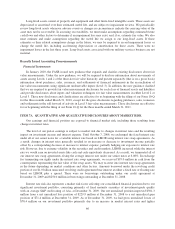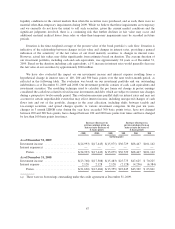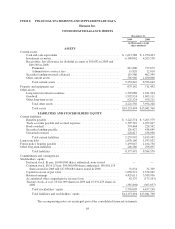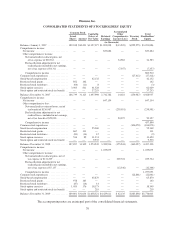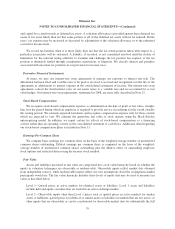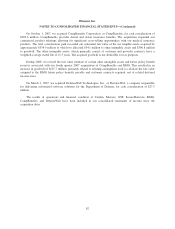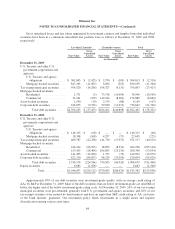Humana 2009 Annual Report Download - page 84
Download and view the complete annual report
Please find page 84 of the 2009 Humana annual report below. You can navigate through the pages in the report by either clicking on the pages listed below, or by using the keyword search tool below to find specific information within the annual report.Humana Inc.
NOTES TO CONSOLIDATED FINANCIAL STATEMENTS—(Continued)
date. For debt securities, we take into account expectations of relevant market and economic data. For example,
with respect to mortgage and asset-backed securities, such data includes underlying loan level data and structural
features such as seniority and other forms of credit enhancements. A decline in fair value is considered other-
than-temporary when we do not expect to recover the entire amortized cost basis of the security. We estimate the
amount of the credit loss component of a debt security as the difference between the amortized cost and the
present value of the expected cash flows of the security. The present value is determined using the best estimate
of future cash flows discounted at the implicit interest rate at the date of purchase.
We participate in a securities lending program to optimize investment income. We loan certain investment
securities for short periods of time in exchange for collateral initially equal to at least 102% of the fair value of
the investment securities on loan. The fair value of the loaned investment securities is monitored on a daily basis,
with additional collateral obtained or refunded as the fair value of the loaned investment securities fluctuates.
The collateral, which may be in the form of cash or U.S. Government securities, is deposited by the borrower
with an independent lending agent. Any cash collateral is recorded on our consolidated balance sheets, along
with a liability to reflect our obligation to return the collateral. The cash collateral is invested by the lending
agent according to our investment guidelines, primarily in money market funds, certificates of deposit, and short-
term corporate and asset-backed securities, and accounted for consistent with our investment securities.
Collateral received in the form of securities is not recorded in our consolidated balance sheets because, absent
default by the borrower, we do not have the right to sell, pledge or otherwise reinvest securities collateral.
Loaned securities continue to be carried as investment securities on the consolidated balance sheets. Earnings on
the invested cash collateral, net of expense, associated with the securities lending payable are recorded as
investment income.
Receivables and Revenue Recognition
We generally establish one-year commercial membership contracts with employer groups, subject to
cancellation by the employer group on 30-day written notice. Our Medicare contracts with CMS renew annually.
Our military services contracts with the federal government and our contracts with various state Medicaid
programs generally are multi-year contracts subject to annual renewal provisions.
We bill and collect premium and administrative fee remittances from employer groups and members in our
Medicare and individual products monthly. We receive monthly premiums and administrative fees from the
federal government and various states according to government specified payment rates and various contractual
terms. Changes in revenues from CMS for our Medicare products resulting from the periodic changes in risk-
adjustment scores for our membership are recognized when the amounts become determinable and the
collectibility is reasonably assured.
Premium revenues are recognized as income in the period members are entitled to receive services, and are
net of estimated uncollectible amounts and retroactive membership adjustments. Retroactive membership
adjustments result from enrollment changes not yet processed, or not yet reported by an employer group or the
government. We routinely monitor the collectibility of specific accounts, the aging of receivables, historical
retroactivity trends, as well as prevailing and anticipated economic conditions, and reflect any required
adjustments in current operations.
Medicare Part D
We cover prescription drug benefits in accordance with Medicare Part D under multiple contracts with
CMS. The payments we receive monthly from CMS and members, which are determined from our annual bid,
represent amounts for providing prescription drug insurance coverage. We recognize premium revenues for
74




